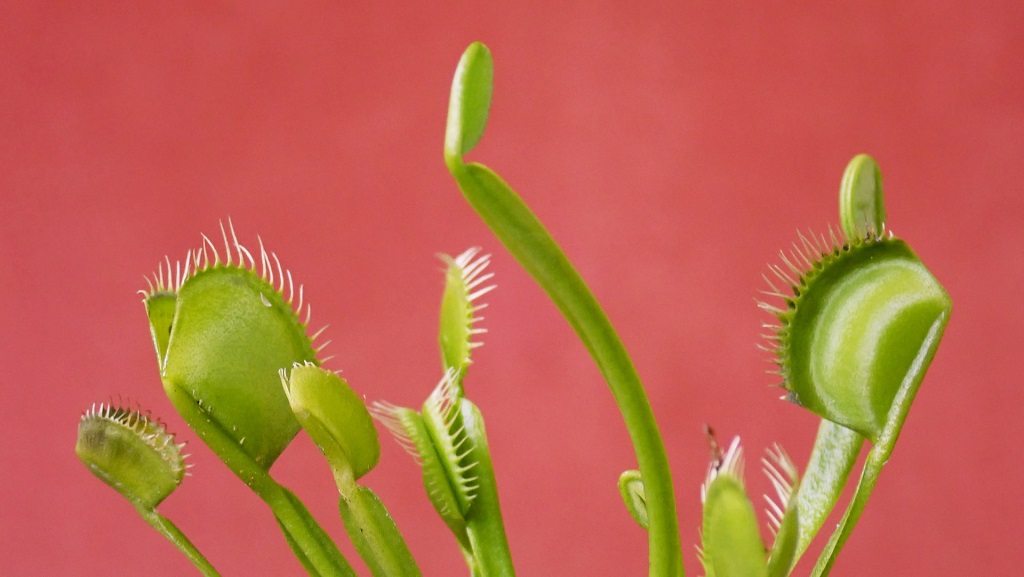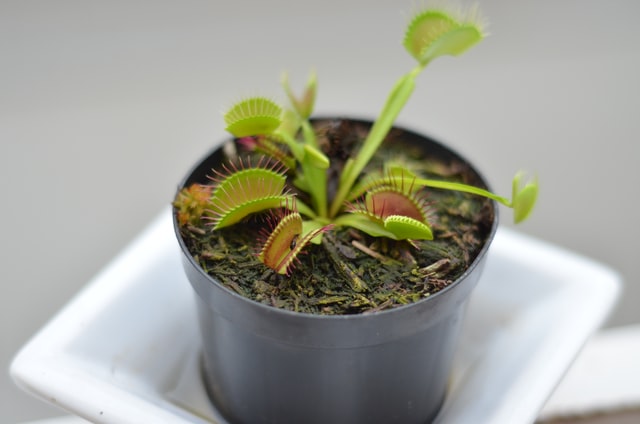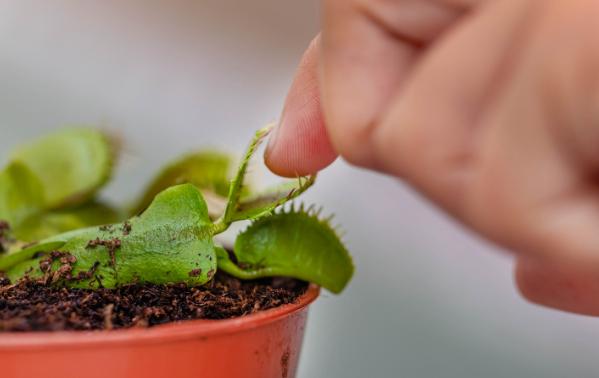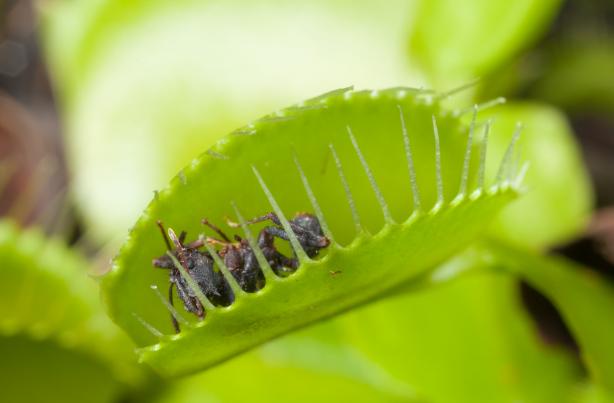
Do you wonder what Venus Flytrap care requires? How does this plant feed? Is it toxic to you or your pet? In the article, we answered those and other questions from the water needs and temperature requirements to humidity, soil, and propagation.
| Botanical Name (Latin Name/Scientific Name): | Dionaea Muscipula |
| Common Name: | Venus Flytrap |
| Light: | Full sun (10,000 lux – 40,000+ lux) |
| Watering: | when the topsoil dries out (distilled water or rainwater only) |
| Soil: | pure unenriched peat moss or carnivorous soil mix |
| Repotting: | once a year |
| Temperature: | 21°C to 30°C (70°F to 86°F), can tolerate as low as 0C (32F) |
| Humidity: | adult plants: any humidity; young plants: over 70% |
| Toxicity for Pets: | non-toxic |
| Toxicity for Humans: | not likely |
| Propagation: |
|
| Pruning: | only prune dead and diseased growth or when you want the plant to branch out |
Light Requirements
| Minimal amount of light | 10,000 lux (1,000 FC) |
| Optimal amount of light: | 40,000+ lux (4,000+ FC) |
| Direct sun tolerance: | 8 hours |
| Category: | Full Sun |
Whether you’ve purchased your first Venus Fly Trap plant or are just looking for Venus Flytrap facts, you’ve come to the right place. To succeed with your Venus Flytrap care you will need to get the basics right. Let’s get started by finding the perfect place in your home. Look for a spot with partial to full sun. Venus flytraps grow in almost full sun in nature and you want to replicate these conditions in your home as closely as possible. I recommend a lovely spot on your window sill or a bright spot in your sunroom. Remember that light intensity drops exponentially with distance from windows, so only 1 or 2 feet away from a window can dramatically reduce the amount of light your flytrap gets.
Water Needs
The other incredibly important part to help your flytrap flourish is to water it properly. It is essential to use only distilled or demineralized water, rainwater, or reverse osmosis water. Tap water should not be used. The water from the tap contains minerals and they will slowly kill your new favorite plant. And, despite the commonly shared advice – do not keep fly traps sitting in water. Instead, make sure that the soil never fully dries out. As soon as you notice the top half-inch of soil has dried out, water it immediately.
Even though having a flytrap sitting in water can work for some people (if the plant is potted in a well-draining mix, with lots of oxygen for the roots and is getting a lot of direct sun), most people don’t provide such good conditions, so letting fly traps constantly sit in water can lead to root rot for others.
Humidity Needs
Humidity is not important for mature plants, they will grow just fine in very low humidity, but high humidity is critical when growing flytraps from seeds or working with young plants.
Temperature Requirements
You want to give them space where they can enjoy temps around 21°C to 30°C (70°F to 86°F).

Venus Flytrap enjoys a warm enviroment
Fertilizing
Venus flytraps are native to nutrient-poor environments and obtain most of their nutrients from the insects they capturetherefore it is not necessary to fertilize Venus flytraps. In fact, fertilizing the plant can be harmful, as the extra nutrients can burn the plant’s roots and even lead to the plant’s death. It is generally recommended to not fertilize Venus flytraps at all and instead allow the plant to obtain its nutrients naturally through insect capture. Fertilizing is only recommended for very experienced growers, in very small quantities.
If you’re feeling adventurous, you can feed the plant live insects like spiders, crickets, and other small bugs. But be aware, this is not a replacement for good light and plenty of direct sun. Plants need sun to photosynthesize and flytraps are no different.
Soil
To get the best results use pure, unenriched sphagnum peat moss mixed with perlite (1/2 peat moss, 1/2 perlite) or long-fibered sphagnum moss. Venus flytraps only grow naturally in one place in the world: North and South Carolina. Unlike many plants that thrive on the minerals and nutrients in soil, your new plant friend lives a life of hardship. The flytraps grow in acidic soil with poor nutrient content. Using regular potting soil will slowly kill them due to mineral content and synthetic fertilizer.
Repotting
If you want your Fly Traps to thrive then they need to be repotted annually. Over the course of a year the soil will compact, which will reduce the amount of oxygen available to the roots and will increase the chances of root rot.
The process is fairly straightforward. Start by completely removing the old medium. Inspect the rhizomes (white hard parts below the soil), if you notice any brown or black parts, cut them off. Also if any parts of the rhizomes are soft and mushy, cut them off. The roots that come out of the rhizomes are supposed to be black – DO NOT cut them off! Once you’ve made sure the rhizomes are white, hard and healthy, pot into a fresh potting mix. As I mentioned before, you want to use pure, unenriched sphagnum peat moss (mixed with 50% perlite) or long-fibered sphagnum moss to help your plant thrive.
Toxicity for Humans
The plant’s digestive enzymes are not strong enough to harm people, and the plant’s small size makes it unlikely that a person would accidentally ingest a significant amount of the plant’s tissue.

You can touch your Venus Flytrap since it is a non-toxic plant
Toxicity for Pets
According to the American Society for the Prevention of Cruelty to Animals (ASPCA), Venus Flytraps are non-toxic to dogs, cats, and horses.
Pruning
If there are black and dry (dead) leaves or traps on a Venus Flytrap plant, use sharp, sterilized pruning shears or scissors to remove them. Prune the leaves at the bottom of the petiole, near the base of the plant and discard them.
Hibernation
We all need a break from time-to-time and your Venus flytrap plant is no different. In fact, it is more like a bear in that it needs a proper seasonal break. Grab your plant and get your hibernation plans ready. I can’t recommend how to prepare a bear for hybernation, but flytraps need a winter dormancy period with a temperature between 0°C and 12°C during winter (32°F to 53°F).
If you have a screened in porch or garage with a sunny window that stays in that temperature range, then it could be a good fit. Be creative and you can find an excellent place for the plant. If in doubt, you can always move to North or South Carolina :)
Reduce the watering frequency during hibernation and use less water when watering. With cooler temperatures the plant will not photosynthesize as much, so will not use water as fast, but make sure the soil doesn’t fully dry out.
Another way to hibernate a Venus Fly Trap is in a fridge. Yes, you heard me right, you can keep them in a fridge. I will cover this in a separate blog post, but it is not something I would recommend unless you are an experienced flytrap grower.
Check out the video below to see how Venus Flytrap looks like after spending three months in the refrigerator:
Propagation
There are three ways you bring more Venus Flytraps into the world:
1. dividing plants,
2. leaf cuttings, and
3. from seeds.
When dividing plants, you should separate offshoots of the plant to be potted separately. Remove all of the soil, find the spot where two rhizomes connect to each other and gently pull them apart. These offshoots should ideally have their own root systems. For best success, try this in the early spring to early summer months.
If you’re more adventurous, you can give leaf cuttings a go. Pull off a few leaves as low as possible (it’s crucial for the leaves to have a white end, this means you were able to pull of a piece of rhizomes with them) and pot them in some sphagnum moss or pure, unenriched peat moss with perlite (50% moss, 50% perlite) and cover to encourage high humidity.
For seeds, you can plant these in a peat moss and perlite mix and maintain a high humidity throughout early growing and past germination. In about 2-3 years you will have a mature plant that can be repotted.
Propagation is a longer topic which I will cover in more detail in a separate post.
FAQs about Venus Flytrap
What Do Venus Flytraps Eat?
Venus Flytraps eat ants, beetles, grasshoppers, spiders and other insects. It takes a Venus flytrap three to five days to digest them.

Dionaea Muscipula is eating
Can You Feed a Venus Flytrap Dead Bugs?
Yes you can. It requires stimulating the trigger hairs because movement triggers the traps to close and keeps the traps engaged.
How Does a Venus Flytrap Plant Digest What It Eats?
Venus fly trap has special glands that produce enzymes that allow for digestion. These enzymes will extract nutrients out of the trapped insect and when the plant is done and opens up, all that will be left is the insect exoskeleton.
How Big Can a Venus Flytrap Get?
Venus Flytraps get 5-6 inches in diameter and the traps grow up to 1 inch in length. Traps of some hybrid venus Flytraps such as B52 can reach 2 inches in length.
The Venus Flytrap was my first houseplant love. It is the most well-known carnivorous plant and can bring lots of joy to the plant-lover in all of us. Please share this post with your friends and family who are struggling with a plant or are just curious to know more about them. You can also reach me via social media.
Is It Okay To Touch A Venus Flytrap?
It is okay to touch a Venus Flytrap if the plant is healthy and has a lot of traps. If the plant only has a few traps and isn’t healthy, touching it will waste its energy. Check out the video below for more info on whether it’s ok to touch a Venus Flytrap:
Yours Truly,


Related Posts
Alocasia Flying Squid Care (FULL Guide!)
Black Pagoda Lipstick Plant Care (COMPLETE Guide!)
Sansevieria Trifasciata Black Dragon (FULL Guide!)